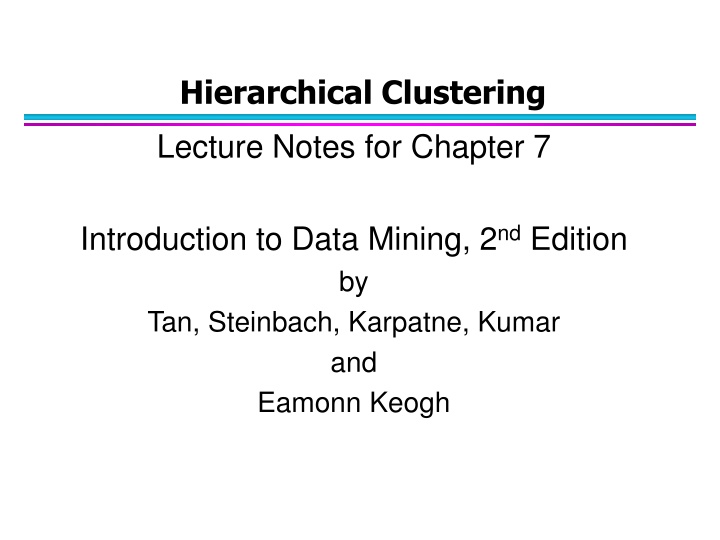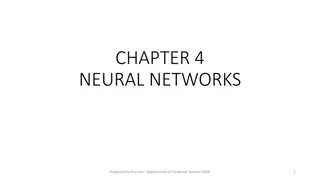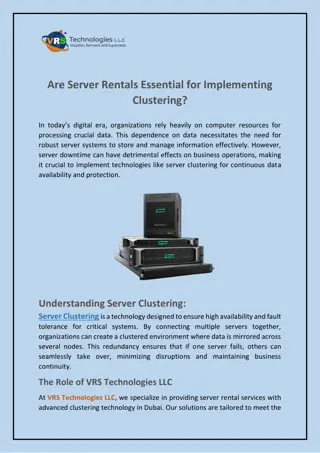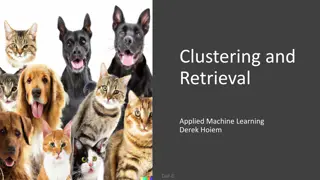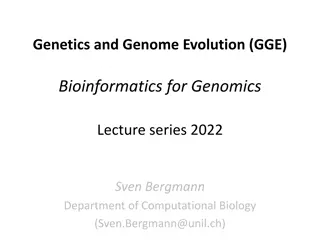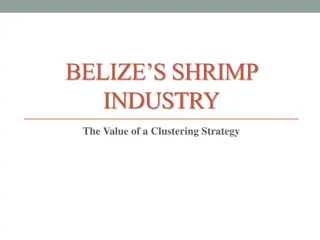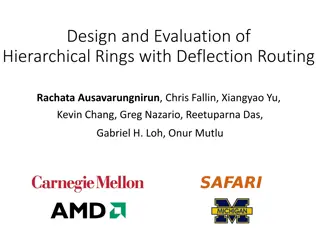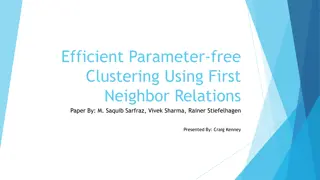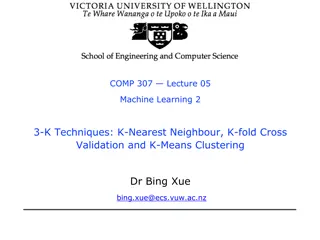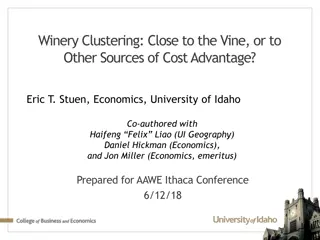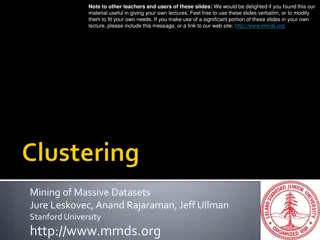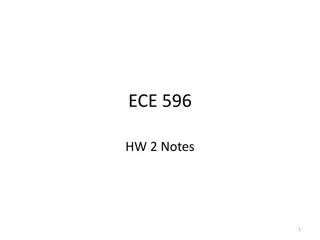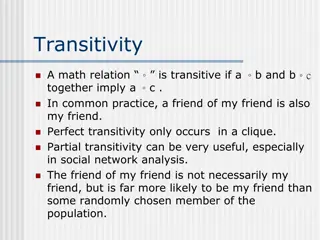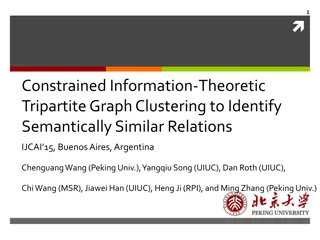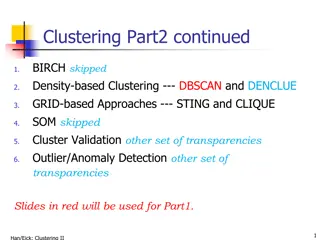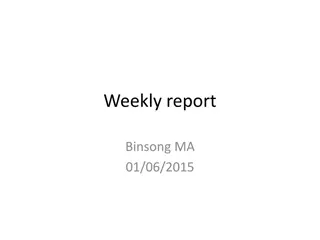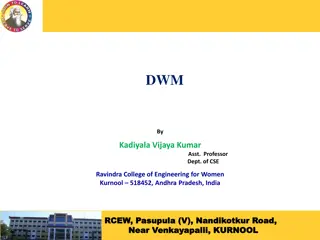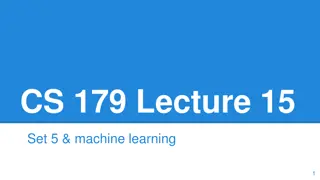Hierarchical Clustering
- Hierarchical clustering is a versatile technique in data mining that creates a hierarchical decomposition of objects based on similarity or distance measures. This clustering method offers insights into data relationships through dendrograms, allowing for the identification of outliers and the exploration of meaningful taxonomies. The process involves agglomerative and divisive algorithms, enabling the flexible creation of cluster sets without assuming a specific number of clusters. With applications in various fields like biological sciences, hierarchical clustering proves valuable in organizing and understanding complex datasets.
Download Presentation

Please find below an Image/Link to download the presentation.
The content on the website is provided AS IS for your information and personal use only. It may not be sold, licensed, or shared on other websites without obtaining consent from the author.If you encounter any issues during the download, it is possible that the publisher has removed the file from their server.
You are allowed to download the files provided on this website for personal or commercial use, subject to the condition that they are used lawfully. All files are the property of their respective owners.
The content on the website is provided AS IS for your information and personal use only. It may not be sold, licensed, or shared on other websites without obtaining consent from the author.
E N D
Presentation Transcript
Hierarchical Clustering Lecture Notes for Chapter 7 Introduction to Data Mining, 2nd Edition by Tan, Steinbach, Karpatne, Kumar and Eamonn Keogh
Slide based on one by Eamonn Keogh Two Types of Clustering Partitional algorithms: Construct various partitions and then evaluate them by some criterion Hierarchical algorithms: Create a hierarchical decomposition of the set of objects using some criterion Partitional Hierarchical 10/14/24 Introduction to Data Mining, 2nd Edition 2
Slide based on one by Eamonn Keogh One potential use of a dendrogram: detecting outliers The single isolated branch is suggestive of a data point that is very different to all others Outlier 10/14/24 Introduction to Data Mining, 2nd Edition 3
Slide based on one by Eamonn Keogh A demonstration of hierarchical clustering using string edit distance 10/14/24 Introduction to Data Mining, 2nd Edition 4
HC Produces Dendrograms What is a Dendrogram? How to use Dendrograms | Displayr 10/14/24 Introduction to Data Mining, 2nd Edition 5
Hierarchical Clustering Two main types of hierarchical clustering algorithms: Agglomerative: Start with the points as individual clusters At each step, merge the closest pair of clusters until only one cluster (or k clusters) left Divisive: Start with one, all-inclusive cluster At each step, split a cluster until each cluster contains an individual point (or there are k clusters) Traditional hierarchical algorithms use a similarity or distance matrix Merge or split one cluster at a time 10/14/24 Introduction to Data Mining, 2nd Edition 6
Strengths of Hierarchical Clustering Constructs sets of clusterings---and not a single clustering--does not have to assume any particular number of clusters: Any desired number of clusters can be obtained by cutting the dendrogram at the proper level They may correspond to meaningful taxonomies Example in biological sciences (e.g., animal kingdom, phylogeny reconstruction, ) 10/14/24 Introduction to Data Mining, 2nd Edition 7
Agglomerative Clustering Algorithm Most popular hierarchical clustering technique Basic algorithm is straightforward 1. Compute the proximity matrix 2. Let each data point be a cluster 3. Repeat 4. Merge the two closest clusters 5. Update the proximity matrix 6. Until only a single cluster remains Key operation is the computation of the proximity of two clusters Different approaches to defining the distance between clusters distinguish the different algorithms 10/14/24 Introduction to Data Mining, 2nd Edition 8
Starting Situation Start with clusters of individual points and a proximity matrix p1 p2 p3 p4 p5 . . . p1 p2 p3 p4 p5 . . Proximity Matrix . ... p1 p2 p3 p4 p9 p10 p11 p12 10/14/24 Introduction to Data Mining, 2nd Edition 9
Intermediate Situation After some merging steps, we have some clusters C1 C2 C3 C4 C5 C1 C2 C3 C3 C4 C4 C5 Proximity Matrix C1 C5 C2 ... p1 p2 p3 p4 p9 p10 p11 p12 10/14/24 Introduction to Data Mining, 2nd Edition 10
Intermediate Situation We want to merge the two closest clusters (C2 and C5) and update the proximity matrix. C1 C2 C3 C4 C5 C1 C2 C3 C3 C4 C4 C5 Proximity Matrix C1 C5 C2 ... p1 p2 p3 p4 p9 p10 p11 p12 10/14/24 Introduction to Data Mining, 2nd Edition 11
After Merging The question is How do we update the proximity matrix? C2 U C5 C1 C3 C4 C1 ? ? ? ? ? C2 U C5 C3 C3 ? C4 ? C4 Proximity Matrix C1 C2 U C5 ... p1 p2 p3 p4 p9 p10 p11 p12 10/14/24 Introduction to Data Mining, 2nd Edition 12
How to Define Inter-Cluster Distance p1 p2 p3 p4 p5 . . . p1 Similarity? p2 p3 p4 p5 MIN MAX Group Average Distance Between Centroids Ward s Method uses squared error . . . Proximity Matrix 10/14/24 Introduction to Data Mining, 2nd Edition 13
How to Define Inter-Cluster Similarity p1 p2 p3 p4 p5 . . . p1 p2 p3 p4 p5 MIN MAX Group Average Distance Between Centroids Other methods driven by an objective function Ward s Method uses squared error . . . Proximity Matrix 10/14/24 Introduction to Data Mining, 2nd Edition 14
How to Define Inter-Cluster Similarity p1 p2 p3 p4 p5 . . . p1 p2 p3 p4 p5 MIN MAX Group Average Distance Between Centroids Other methods driven by an objective function Ward s Method uses squared error . . . Proximity Matrix 10/14/24 Introduction to Data Mining, 2nd Edition 15
How to Define Inter-Cluster Similarity p1 p2 p3 p4 p5 . . . p1 p2 p3 p4 p5 MIN MAX Group Average Distance Between Centroids Other methods driven by an objective function Ward s Method uses squared inside cluster distances after merging. . . . Proximity Matrix 10/14/24 Introduction to Data Mining, 2nd Edition 16
How to Define Inter-Cluster Similarity p1 p2 p3 p4 p5 . . . p1 p2 p3 p4 p5 MIN MAX Group Average Distance Between Centroids Other methods driven by an objective function Ward s Method uses squared error . . . Proximity Matrix 10/14/24 Introduction to Data Mining, 2nd Edition 17
Agglomerative Clustering Algorithm Most popular hierarchical clustering technique Basic algorithm is straightforward 1. Compute the proximity matrix 2. Let each data point be a cluster 3. Repeat 4. Merge the two closest clusters 5. Update the proximity matrix 6. Until only a single cluster remains Key operation is the computation of the proximity of two clusters Different approaches to defining the distance between clusters distinguish the different algorithms 10/14/24 Introduction to Data Mining, 2nd Edition 18
MIN or Single Link Proximity of two clusters is based on the two closest points in the different clusters Determined by one pair of points, i.e., by one link in the proximity graph Example: Distance Matrix: 10/14/24 Introduction to Data Mining, 2nd Edition 19
Hierarchical Clustering: MIN 5 1 3 5 0.2 2 1 0.15 2 3 6 0.1 0.05 4 4 0 3 6 2 5 4 1 Nested Clusters Dendrogram 10/14/24 Introduction to Data Mining, 2nd Edition 20
Strength of MIN Original Points Six Clusters Can handle non-elliptical shapes 10/14/24 Introduction to Data Mining, 2nd Edition 21
Limitations of MIN Two Clusters Original Points Sensitive to noise and outliers Three Clusters 10/14/24 Introduction to Data Mining, 2nd Edition 22
MAX or Complete Linkage Proximity of two clusters is based on the two most distant points in the different clusters Determined by all pairs of points in the two clusters Distance Matrix: 10/14/24 Introduction to Data Mining, 2nd Edition 23
Hierarchical Clustering: MAX 4 1 2 5 0.4 0.35 5 2 0.3 0.25 3 6 0.2 3 0.15 1 0.1 4 0.05 0 3 6 4 1 2 5 Nested Clusters Dendrogram 10/14/24 Introduction to Data Mining, 2nd Edition 24
Strength of MAX Original Points Two Clusters Less susceptible to noise and outliers 10/14/24 Introduction to Data Mining, 2nd Edition 25
Limitations of MAX Original Points Two Clusters Tends to break large clusters Biased towards globular clusters 10/14/24 Introduction to Data Mining, 2nd Edition 26
Group Average Proximity of two clusters is the average of pairwise proximity between points in the two clusters. proximity( Cluster j p , p ) i j p i i p Cluster = proximity( Cluster , Cluster ) j i j |Cluster |Cluster | | i j Need to use average connectivity for scalability since total proximity favors large clusters Distance Matrix: 10/14/24 Introduction to Data Mining, 2nd Edition 27
Hierarchical Clustering: Group Average 5 4 1 2 0.25 5 0.2 2 0.15 3 6 0.1 1 0.05 4 0 3 3 6 4 1 2 5 Nested Clusters Dendrogram 10/14/24 Introduction to Data Mining, 2nd Edition 28
Hierarchical Clustering: Group Average Compromise between Single and Complete Link Strengths Less susceptible to noise and outliers Limitations Biased towards globular clusters 10/14/24 Introduction to Data Mining, 2nd Edition 29
Cluster Similarity: Wards Method Similarity of two clusters is based on the increase in squared error (see below)---average squared inside cluster distance---after two clusters are merged; somewhat similar to group average. Ward's method Wikipedia (Average Squared inside cluster distances C1 C2)/(Average squared cluster distances inside both C1 and C2) Less susceptible to noise and outliers Biased towards globular clusters Hierarchical analogue of K-means Can be used to initialize K-means 10/14/24 Introduction to Data Mining, 2nd Edition 30
Inside Cluster Distance (Sum of the distances of all pairs of objects in the cluster)/(number of pairs of objects) C1 C2 additionally contains the edges depicted in brown! cohesion 10/14/24 Introduction to Data Mining, 2nd Edition 31
Hierarchical Clustering: Comparison 5 1 4 1 3 5 2 5 5 2 1 2 MIN MAX 2 3 6 3 6 3 1 4 4 4 5 5 1 4 1 2 2 5 5 Ward s Method 2 2 Group Average 3 3 6 6 3 1 1 4 4 4 3 10/14/24 Introduction to Data Mining, 2nd Edition 32
MST: Divisive Hierarchical Clustering Build MST (Minimum Spanning Tree) Start with a tree that consists of any point Create subclusters by breaking links in the minimum spanning tree https://en.wikipedia.org/wiki/Minimum_spanning_tree 10/14/24 Introduction to Data Mining, 2nd Edition 33
MST: Divisive Hierarchical Clustering Use MST for constructing hierarchy of clusters Remark: Selects Splits which maximize inter-cluster distance with respect to C1 and C2 (used to split C). 10/14/24 Introduction to Data Mining, 2nd Edition 34
Hierarchical Clustering: Time and Space Complexity O(N2) space since it uses the proximity matrix. N is the number of points. O(N3) time in many cases There are N steps and at each step the size, N2, proximity matrix must be updated and searched Complexity can be reduced to O(N2 log(N) ) time with some cleverness 10/14/24 Introduction to Data Mining, 2nd Edition 35
Hierarchical Clustering: Problems and Limitations Once a decision is made to combine two clusters, it cannot be undone greedy algorithm No global objective function is directly minimized Different schemes have problems with one or more of the following: Sensitivity to noise and outliers Difficulty handling clusters of different sizes and non-globular shapes Breaking large clusters In comparison to other methods: does not search a lot of clusterings and therefore sometimes misses promising clusterings. 10/14/24 Introduction to Data Mining, 2nd Edition 36
